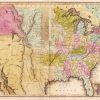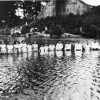calsfoundation@cals.org
Charles Rice Kellam (1809–1854)
Charles Rice Kellam was a Baptist missionary to the newly established Indian Territory (present-day Oklahoma) in the 1830s. He later moved to Arkansas and settled in Franklin County, where he was a minister, educator, and entrepreneur. His efforts would lead to the establishment of the town of Charleston.
Charles Kellam was born on May 11, 1809, in Barre, Vermont, into a devoutly Baptist family and extended community. When he was three years old, his father died, and he went to live with his uncle, Sabin Kellam, in nearby Irasburg, Vermont. Irasburg was also the home of his grandfather, Nathanial Kellam, known simply as “Deacon Kellam” for his years of service in the Baptist Church. As an eloquent speaker in his ministry, he no doubt had a great influence on his grandson.
In the fall of 1831, Kellam entered Hamilton Literary and Theological Institution (now known as Colgate University) in Hamilton, New York, with the goal of becoming a missionary. Desiring to get into the field as quickly as possible, he opted for an abridged curriculum. Prior to his graduation, he wrote to the Baptist Board of Foreign Missions offering his services to promote the well-being of the “miserable heathen.” The board quickly obliged, and in October 1836, Kellam, newly ordained and married, departed for the Creek Nation with his wife, Elizabeth Pearson Kellam. Their shared mission was two-fold: to spread the gospel at the behest of the Baptist Board and to participate in the U.S. government’s treaty-mandated program of Indian education.
This first of two forays into the west (which had just started to see some success) ended after a year and a half when Elizabeth fell ill. She died on February 2, 1838, leaving Kellam with a five-month-old son.
Kellam returned east to seek assistance. Leaving his son in the care of the fellow missionaries, he made a whirlwind preaching tour of eastern states and into Canada. On September 13, 1838, he again departed for the Indian Territory, in the company of four other missionaries, one of whom was his new wife, Susan Carter Kellam.
While Kellam’s gospel was well received by many among the Creek (Muscogee) Indians, it was more readily embraced by the African Americans they enslaved. This led to fear among some chiefs that the seeds of abolitionism were being sown. As animosity intensified, one of the missionaries was fired upon and almost killed, and Kellam faced death threats. (Information suggests that Kellam and his family opposed slavery. In the runup to the Civil War, his elder son moved to Vermont and later joined the Union army, and just before the war started, Kellam’s widow wrote to her stepson expressing dismay and alarm at the attitudes of some of Charleston’s citizens.) Despite the gains they had achieved, to preserve the peace and for their own protection, the missionaries were banned from the Creek Nation. In 1840, Kellam reluctantly relocated his preaching and teaching efforts approximately seventy miles to the east, focusing on members of his own race.
After a short time in Van Buren (Crawford County), he began to acquire land in Franklin County. In 1843, he and his wife opened a boarding school, the Franklin Seminary, the exact location unknown.
In addition to the school, Kellam organized the First Baptist Church in 1846. He also operated a dry-goods store, which apparently also served as a post office, and was appointed postmaster of the newly christened “Charlestown,” named for him, in 1846.
Kellam was active regionally, preaching on a weekly basis, contributing to area newspapers, and promoting roads and railroads for the western part of the state. Maintaining strong ties to the communities and churches of his youth, he made at least one additional trip back to Vermont, where he preached and gave talks about his experiences in the west.
Charles and Susan Kellam had two children, both born in Charleston: Edward P. Kellam and Mary B. Kellam. They also raised his first son, Charles Roderick Judson Kellam, who had been born in the Creek Nation.
Kellam died in Charleston on April 4, 1854, possibly still suffering from a malarial condition he had first contracted on his arrival at the Indian Territory in 1836. He is buried in Parks Cemetery in Charleston.
For additional information:
“Creek Agency, 1824–1876: 1839–1842.” National Archives Catalog. https://catalog.archives.gov/id/163863352 (accessed August 29, 2025).
“Franklin Seminary.” Arkansas Intelligencer, April 22, 1843.
History of Benton, Washington, Carroll, Madison, Crawford, Franklin, and Sebastian Counties, Arkansas. Chicago, IL: Goodspeed Publishing Co., 1889.
“Kellam, Charles R., 1836–1842.” American Baptist Historical Society. https://abhs.access.preservica.com/archive/sdb%3Acollection|2002240d-050f-46a4-890b-630910085a32/ (accessed August 29, 2025).
“Letter from Brother Kellam.” Vermont Telegraph, February 27, 1839.
McCoy, Isaac. History of the Baptist Indian Missions. Washington DC: William M. Morrison, 1840.
Saunt, Claudio. Black, White, and Indian: Race and the Unmaking of an American Family. New York: Oxford University Press, 2005.
“Vermont Reminiscences and Renaissance.” Burlington Free Press, October 9, 1930.
Zellar, Gary. African Creeks: Estelvste and the Creek Nation. Norman: University of Oklahoma Press, 2007.
Joe Huck
Magazine, Arkansas








Comments
No comments on this entry yet.